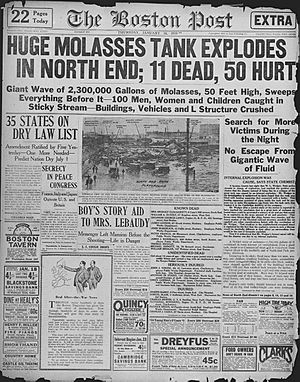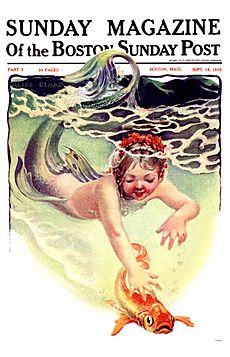The Boston Post facts for kids

The front page of The Boston Post
(January 16, 1919) |
|
| Type | Daily newspaper |
|---|---|
| Format | Broadsheet |
| Owner(s) | Post Publishing Company |
| Founded | 1831 |
| Language | English |
| Ceased publication | 1956 |
| Headquarters | 42 Congress Street; Corner Devonshire & Water Streets; 15–17 Milk Street Boston, Mass., |
The Boston Post was a popular newspaper that was printed in Boston, Massachusetts. It was published for a very long time, from 1831 until 1956. For more than 100 years, it was one of the most widely read daily newspapers in the New England area.
Two business owners, Charles G. Greene and William Beals, started the Post in November 1831. By the 1930s, The Boston Post had become one of the biggest newspapers in the entire country. It had more than a million readers every day!
However, in the 1940s, the newspaper faced tough competition. Other papers, like those owned by William Hearst, became very popular. Also, more and more people started getting their news from radio and television. This meant fewer people bought newspapers, and The Boston Post's business began to struggle.
The newspaper stopped being published in October 1956. At that time, it was still printing about 255,000 copies of its daily paper. Its Sunday edition was even more popular, with about 260,000 copies printed.
Contents
People Who Wrote for The Post
Many talented people worked as writers for The Boston Post. Here are a few of them:
- Richard Frothingham, Jr. – He was a historian, a journalist, and a politician. He also helped manage The Boston Post.
- Olin Downes – He was a music critic, which means he wrote about music and concerts.
- Olga Van Slyke Owens Huckins – She was the literary editor from 1941 to 1954. She wrote a letter to Rachel Carson that helped inspire the famous book Silent Spring.
The Sunday Magazine
Every Sunday, the newspaper included a special weekly magazine. It was first called "The Sunday Magazine of The Boston Sunday Post." Later, its name was shortened to "The Boston Sunday Post Sunday Magazine." These magazines often had interesting stories, pictures, and articles for readers to enjoy on the weekend.
Winning the Pulitzer Prize
In 1921, The Boston Post won a very important award called the Pulitzer Prize. This award is given for excellent work in journalism. The Boston Post won for "Meritorious Public Service."
They earned this prize because they investigated and showed how a man named Charles Ponzi was cheating people. He ran a "Ponzi scheme," which is a type of fraud where people are tricked into investing money, but the money is used to pay earlier investors rather than from real profits. The Boston Post's reporting helped expose this scam.
This was the last Pulitzer Prize for public service won by a Boston newspaper for a long time. Another Boston paper, The Globe, didn't win this award again until 2003.
The Boston Post Cane Tradition
The Boston Post Cane is a special award that many towns in New England still give out today. It's given to their oldest living citizen!
This tradition started in 1909 when Edwin A. Grozier owned The Boston Post newspaper. The newspaper had hundreds of fancy, gold-tipped canes made. These canes were then given to each town's oldest living man in a special ceremony.
In 1930, the custom was expanded to include the oldest women in the community too. Many towns in New England still keep this Boston Post cane tradition alive. They use the very same original canes they received back in 1909!
When the person holding the cane passes away (or moves away from the community), the cane is then passed on to the next oldest living resident in that town. It's a wonderful way to honor the oldest members of a community.
Images for kids
-
The Boston Post Building 15–17 Milk Street, Boston, Massachusetts





